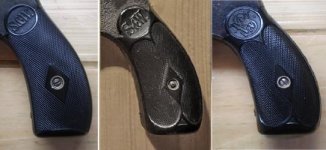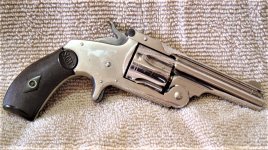I went to my usual range/LGS today to arrange a shipment and was blinded by this brilliant shorter-barrel (3 1/4") .38 SA 2nd Model on the Used Gun shelf. I looked it over, noted the click-snap tightness of the action and latch, found only the shallowest tiny scratches in the nickel, thought the price was reasonable for its condition -- and bought it on the spot.
The serial number is 50380; the same number is found on the appropriate parts in addition to the frame. There is no serial number on either cheek piece. The interior surfaces of the stocks show tiny radiating age cracks around the screw holes. There are no visible hairline cracks on the exteriors, but the right cheek piece has suffered a breakout at the bottom. The damage is confined to the plane of the frame's butt and does not affect the checking field. I thought at first I might attempt a repair, but have decided not to. The revolver has a history that it should be allowed to keep.


I initially guessed a date in the mid-1880s for this revolver, but the S&W historian informs me it was actually shipped in April, 1880.
Here us a photo of one cheek piece of the somewhat rare Type 2 hard rubber stocks mentioned in a post below.

The frame, latch and cylinder are all numbered alike. Poor lighting makes the number on the underside of the latch illegible in this photo; only the first two digits on the frame are clearly visible, with the latter three digits lost in the shadow and unpolished surface of the part.
 .
.
With the frame broken open and the cylinder removed, we see the fixed spindle that holds the cylinder in position.

The end of the spindle has a short, coarse thread onto which the cylinder is screwed until it reaches a position where the front face is up against the rear of the barrel and the cylinder is far enough forward that it clears the coarse thread and can spin freely. Removing the cylinder involves pulling it back and turning counterclockwise until it engages the course thread and backs off the spindle. One must lift the latch while removing or installing the cylinder, or the downward protrusion will contact and mark the surface of the cylinder.

Unfamiliar as I was with the action of the S&W SAs of the 1870s-1880s, I was surprised to find that the cylinder locks up only with the hammer at full cock or full forward rest. There is a half-cock position, which I think of as 1/16-cock because it is back from full forward by such a tiny amount. This position permits the cylinder to spin freely, which is a little surprising, but it also guarantees that the hammer nose will never protrude through the recoil shield without an intentional full cock and subsequent trigger release. With no need to leave a chamber empty under the resting hammer (though that practice is available for those who might not want a freely spinning cylinder on the gun in one's pocket), one could carry a full five rounds in this revolver.
I have a few specimens of tip-ups and top-breaks. This one is easily the best-preserved member of that group.
The serial number is 50380; the same number is found on the appropriate parts in addition to the frame. There is no serial number on either cheek piece. The interior surfaces of the stocks show tiny radiating age cracks around the screw holes. There are no visible hairline cracks on the exteriors, but the right cheek piece has suffered a breakout at the bottom. The damage is confined to the plane of the frame's butt and does not affect the checking field. I thought at first I might attempt a repair, but have decided not to. The revolver has a history that it should be allowed to keep.


I initially guessed a date in the mid-1880s for this revolver, but the S&W historian informs me it was actually shipped in April, 1880.
Here us a photo of one cheek piece of the somewhat rare Type 2 hard rubber stocks mentioned in a post below.

The frame, latch and cylinder are all numbered alike. Poor lighting makes the number on the underside of the latch illegible in this photo; only the first two digits on the frame are clearly visible, with the latter three digits lost in the shadow and unpolished surface of the part.

With the frame broken open and the cylinder removed, we see the fixed spindle that holds the cylinder in position.

The end of the spindle has a short, coarse thread onto which the cylinder is screwed until it reaches a position where the front face is up against the rear of the barrel and the cylinder is far enough forward that it clears the coarse thread and can spin freely. Removing the cylinder involves pulling it back and turning counterclockwise until it engages the course thread and backs off the spindle. One must lift the latch while removing or installing the cylinder, or the downward protrusion will contact and mark the surface of the cylinder.

Unfamiliar as I was with the action of the S&W SAs of the 1870s-1880s, I was surprised to find that the cylinder locks up only with the hammer at full cock or full forward rest. There is a half-cock position, which I think of as 1/16-cock because it is back from full forward by such a tiny amount. This position permits the cylinder to spin freely, which is a little surprising, but it also guarantees that the hammer nose will never protrude through the recoil shield without an intentional full cock and subsequent trigger release. With no need to leave a chamber empty under the resting hammer (though that practice is available for those who might not want a freely spinning cylinder on the gun in one's pocket), one could carry a full five rounds in this revolver.
I have a few specimens of tip-ups and top-breaks. This one is easily the best-preserved member of that group.
Last edited:







